Cadex has officially launched the Tri frameset, its new triathlon-specific bike with a design that harks back to the monocoque frames of the 1990s.
The new frameset module was developed in conjunction with World and Olympic triathlon champion Kristian Blummenfelt, using extensive CFD (computational fluid dynamics) and wind tunnel testing.
A new set of time trial and triathlon-specific wheels have also been announced, including a full-carbon rear disc wheel and a set of four-spoke carbon wheels.
Blummenfelt has already used the new bike and wheels to good effect, winning the delayed 2021 Ironman World Championship on 7 May 2022, and completing the first sub seven-hour Ironman triathlon on 5 June 2022.
While the triathlon world is no stranger to UCI rule-breaking bikes, the Cadex Tri frameset joins a select club of bikes, such as the Cervélo P5X and Ceepo Shadow. These bikes take their primary design cues from the radical monocoque carbon frames of the 1990s, such as the Lotus Sport 110.
Cadex Tri frameset key specs
- Triathlon-specific monocoque aero frameset module with a double-crown, wide-leg fork
- Price: £6,499 / €6,999 / AU$8,999
- Claimed weight: 4,577g (frame, fork, cockpit and internal storage system)
Endurance aero

While the riding position is similar to that seen in time trials, the Cadex Tri frameset completely ignores the UCI’s (Union Cycliste Internationale, cycling’s governing body) infamously restrictive technical regulations.
Designed by a team led by aerodynamics expert Xavier Gergaud, who previously worked with Giant (Cadex’s parent brand) on bikes such as the Propel Advanced Disc and Trinity Advanced Pro, the most obvious features a UCI commissaire would take issue with are the missing top tube and enormous aerofoil down tube.
As well as being aerodynamically efficient (because there’s less material to interrupt the airflow), the missing top tube is an ideal feature for a triathlon-specific bike, because it makes it easier to access the bike’s integrated storage systems in its massive down tube.
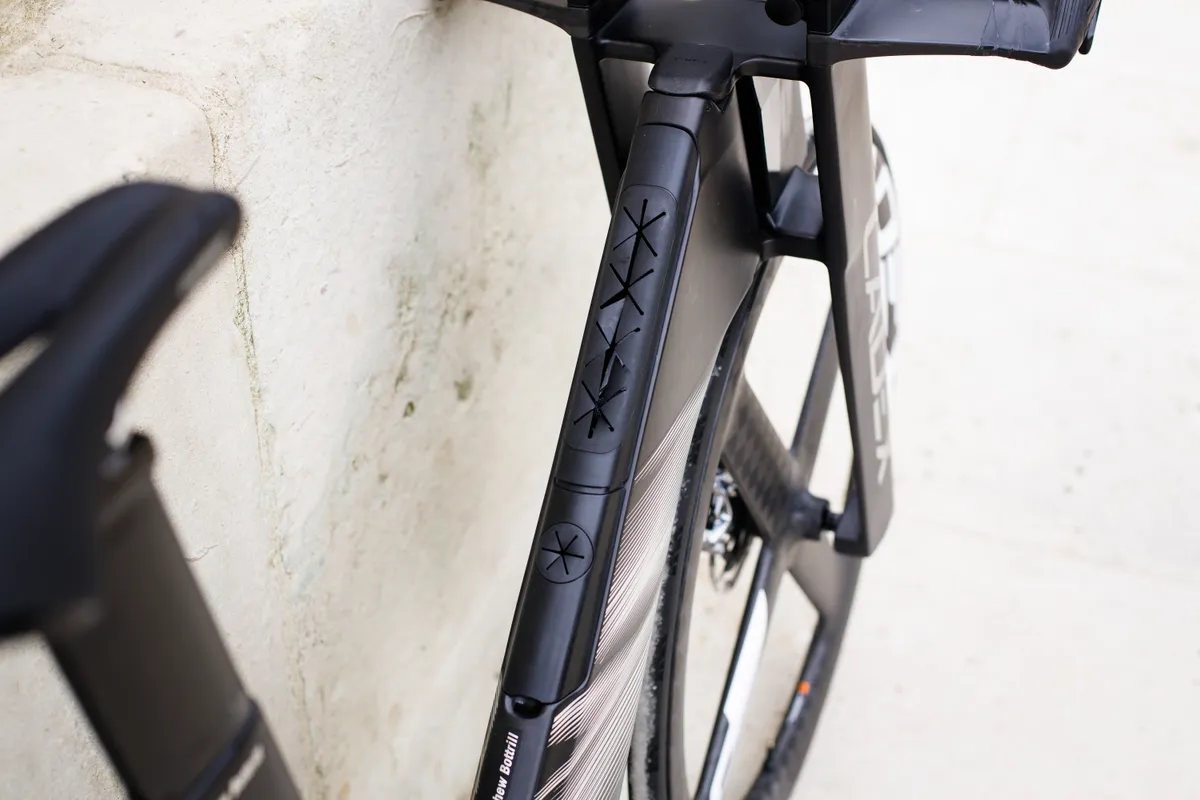
To cope with the demands of a 180km unsupported bike leg (as featured in Ironman triathlons), the Cadex Tri frameset focuses heavily on the rider’s ability to carry and consume fuel and fluids on the bike in an aerodynamically optimised manner.
As such, the down tube features an internal bladder for fluids, ranging from 600ml on the smallest frames, up to 1,000ml on the largest.
A straw runs internally through the frame, coming out between the armrests at the front of the bike. This allows the rider to drink without needing to exit the aero position.
The bladder can also be refilled on the move via a small port on the top of the down tube, using a standard cycling water bottle.
The down tube also features a removable bento box, which has capacity for up to 10 32ml gels on the largest frame.
A toolbox is also housed above the bottom bracket, with enough room for a multi-tool, tyre levers, a CO2 inflator and a spare inner tube.
Double-crown fork
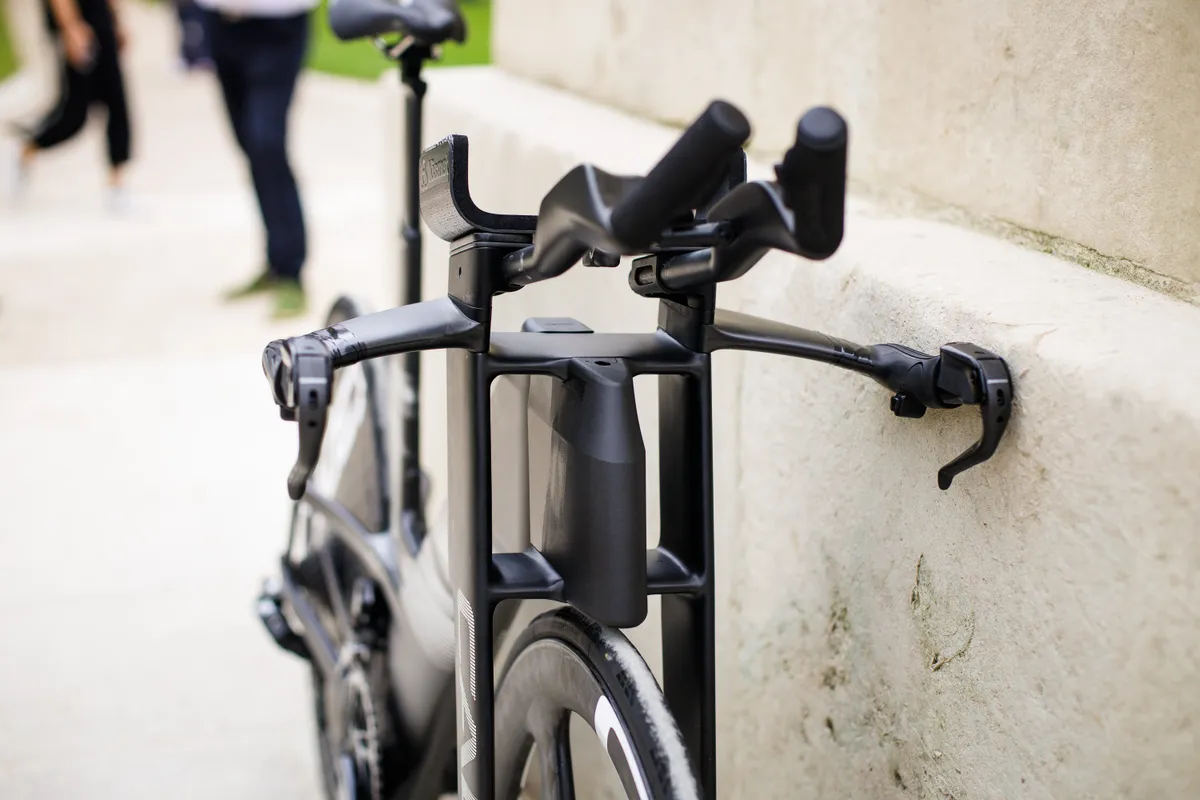
The fork uses a wide-stance design, with the upper stanchions flowing directly into the base bar and armrest stacks.
This design is claimed to afford the Cadex Tri frameset “class-leading pedalling and torsional stiffness”, for improved power transfer and handling performance.

Though the fork legs aren’t as wide as those on the Hope HB.T, Cadex says the aerodynamic effect works in a similar manner, with the fork legs breaking the airflow over the rider’s legs.
The heavily dropped chainstays are then placed directly in line with the fork legs, which, Cadex claims, effectively hides them from the wind.
Combined with the huge aerofoil tube sections of the frame, Cadex claims the Tri frameset matches “the fastest non UCI-regulated triathlon bikes”, such as the Cervélo P5X and Canyon Speedmax CFR.
Perfect fit
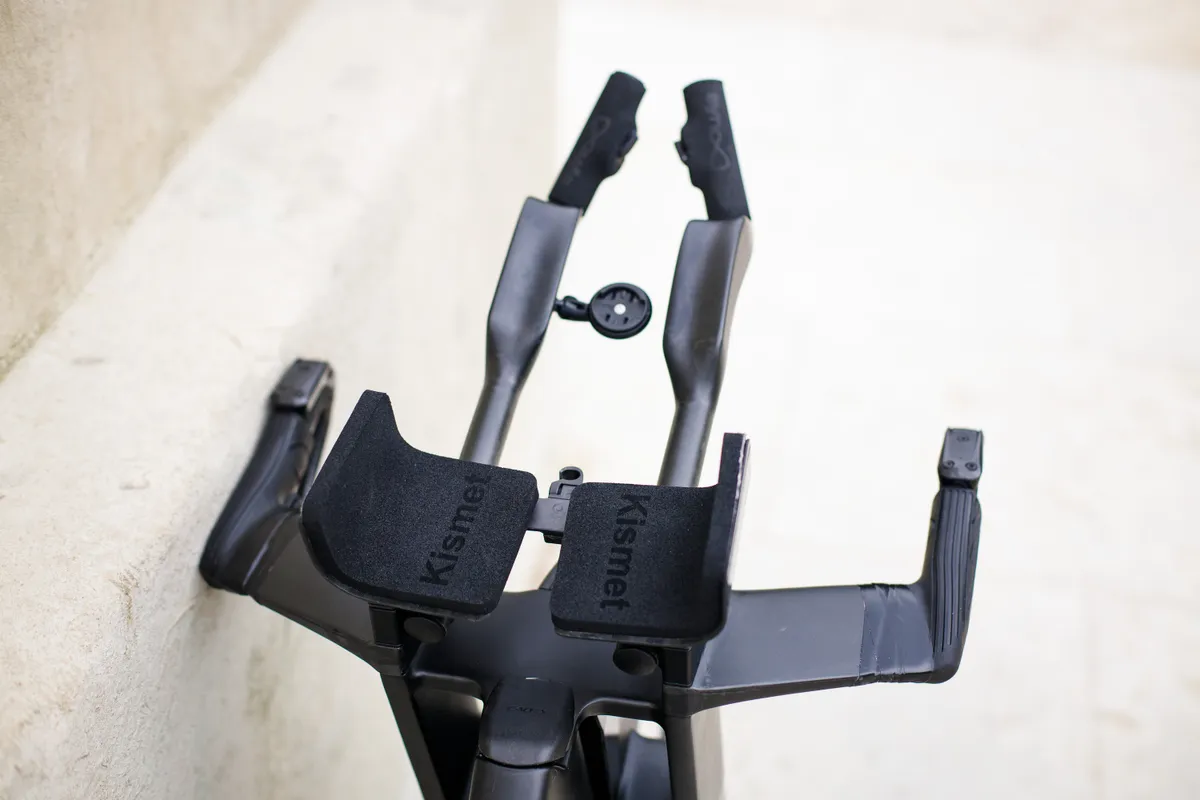
Because the rider is the main source of aerodynamic drag in the rider-plus-bike system, achieving an optimised position on a time trial or triathlon bike is crucial.
With that in mind, Cadex has designed the aero cockpit of the Tri frameset in conjunction with Sync (a company that specialises in making ergonomic time trial and triathlon cockpits), to be highly and easily adjustable with basic tools.
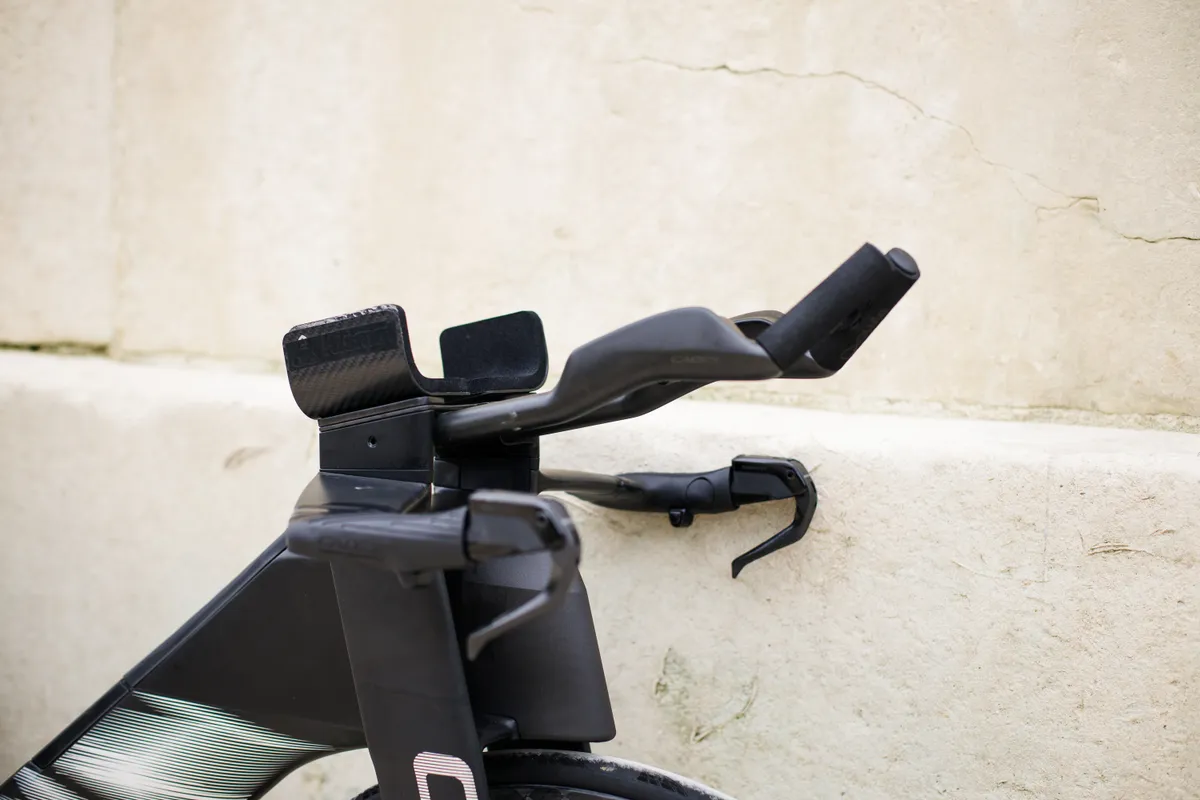
Based on a dataset of 150 professional and amateur triathletes, Cadex is offering the Tri frameset in five different sizes (XXS to L).
Both the base bar and armrest stack and reach can be adjusted across a wide range, as can armrest and extension angle and width.
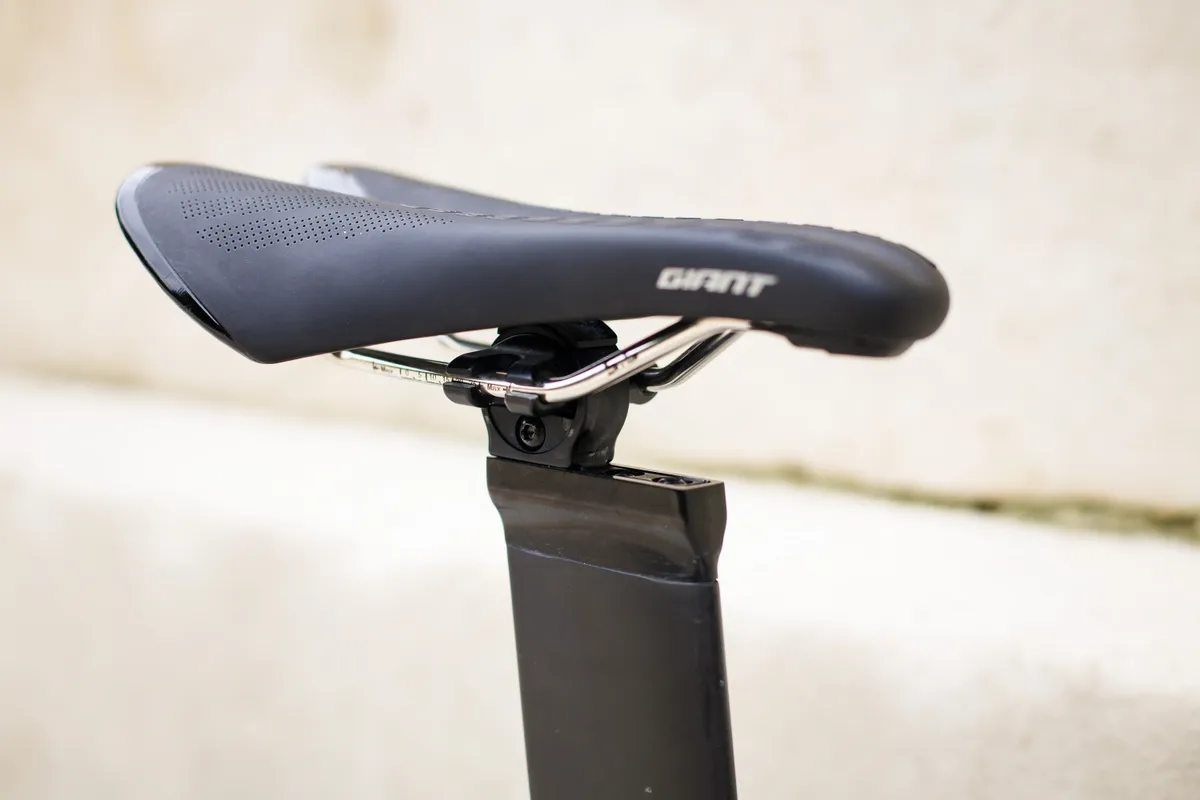
As a triathlon-specific bike designed for primary use in the aero position, the Cadex Tri frameset gets an extremely steep seat angle of 76 to 80 degrees, with 70mm of adjustment in between.
Easy travelling

With triathlons taking place all over the world, travelling with a bike is a key concern for any dedicated triathlete.
Cadex says the Tri frameset design process “factored this into its overall design, minimising the amount of disassembly and reassembly needed”.
The frameset will ship with its own dedicated case, created in collaboration with Topeak, with a specially designed padding system and wheel bags.
Each side of the base bar and the extensions are also easily detachable from the frameset and fork, folding down without any need for disconnecting cables or hydraulic hoses.
An interior mounting system helps protect the bike within the case, but can also be removed for use as a 'mini work stand' at your destination.
Cadex Tri frameset pricing and availability
The Cadex Tri frameset is priced at £6,499 / €6,999 / AU$8,999, which includes the monocoque frame, wide-stance fork and aero cockpit, and a custom, Cadex-branded travelling case for the bike.
Cadex says the Tri frameset can be pre-ordered now, with delivery from October 2022.
Cadex disc wheel and four-spoke carbon wheelset

The brand is also launching a new carbon disc wheel and four-spoke wheel system, both of which Cadex says have been extensively wind tunnel tested.
In the wind tunnel, Cadex used a dynamic moving mannequin to simulate the interaction between rider and wheel that, combined with testing at multiple yaw angles (+/- 20 degrees) and wind speeds, resulted in the optimised rim profiles.
Each is formed using 18K carbon fibre, which is said to optimise stiffness and strength, while the rims feature a lightweight foam plate between the carbon layers that further supports the design.
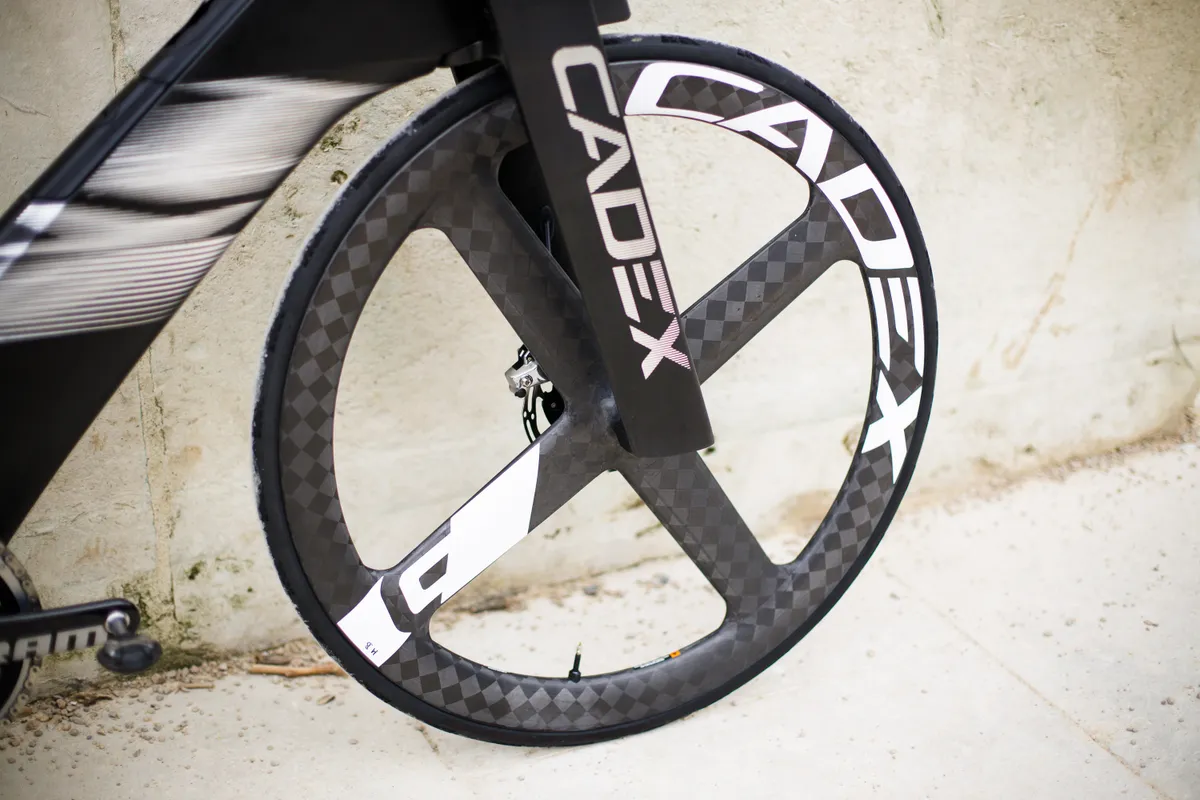
The R3-C40 hubs have ceramic bearings, and the freehub features a new 40-tooth ratchet system, which is said to reduce pedalling friction by 33 per cent and coasting friction by 31.5 per cent versus the previous R1-S30 design.
The rims feature a 22.4mm internal rim width, which Cadex claims enables a rounder, more uniform tyre profile and wider, shorter contact patch. They’re also hookless and are tubeless-ready.
The four-spoke wheel system pairs a 50mm-deep front wheel with a 65mm-deep rear wheel. Thanks to the 20-degree yaw angle testing, Cadex says the wheels should offer maximum aero efficiency while remaining controllable in crosswinds.
Meanwhile, the disc wheel features an asymmetrical profile and is said to save the rider seven watts when paired with a special Cadex Aero tyre (to be launched in the future), compared to “other popular Ironman wheel/tyre systems”.
It also does away with any foam filler, saving weight, as well as any structurally supporting spokes, thanks, Cadex says, to the strength of the 18K weave.
It saves four watts versus the 65mm-deep four-spoke wheel.
Cadex four-spoke and disc wheel pricing and availability
The new wheels are available now, with typical retail prices below.
- Cadex Aero 4-Spoke Disc Tubeless front wheel: £1,499.99 / €1,699 / AU$2,599
- Cadex Aero 4-Spoke Disc Tubeless rear wheel: £1,699.99 / €2,899 / AU$1,899
- Cadex Aero Disc Tubeless Disc-Brake rear wheel: £2,199 / €3,999 / AU$2,299
